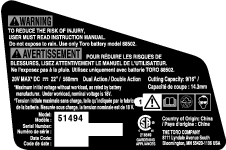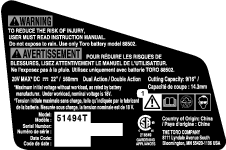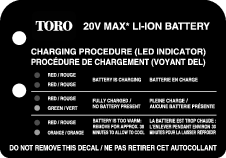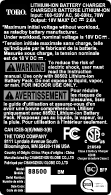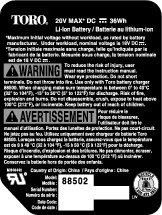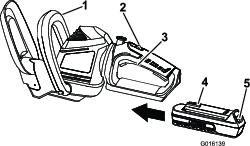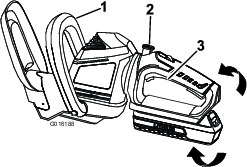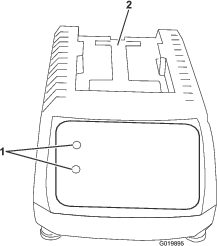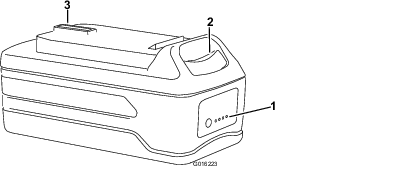 WARNING Read all safety warnings and all instructions. Failure to follow the warnings and instructions may result in electric
shock, fire, and/or serious injury.
WARNING Read all safety warnings and all instructions. Failure to follow the warnings and instructions may result in electric
shock, fire, and/or serious injury.
Save all warnings and instructions for future reference.
The term “power tool” in all of the warnings
listed below refers to your mains-operated (corded) power tool or
battery-operated (cordless) power tool.
-
Work area safety
-
Keep work area clean and well lit.Cluttered or dark areas invite accidents.
-
Do not operate power tools in explosive
atmospheres, such as in the presence of flammable liquids, gases or
dust.Power tools create sparks which may ignite
the dust or fumes.
-
Keep children and bystanders away while
operating a power tool.Distractions can cause
you to lose control.
-
Electrical safety
-
Power tool plugs must match the outlet.
Never modify the plug in any way. Do not use any adapter plugs with
earthed (grounded) power tools.Unmodified plugs
and matching outlets will reduce risk of electric shock.
-
Avoid body contact with earthed or grounded
surfaces such as pipes, radiators, ranges and refrigerators.There is an increased risk of electric shock if your
body is earthed or grounded.
-
Do not abuse the cord. Never use the cord
for carrying, pulling or unplugging the power tool. Keep cord away
from heat, oil, sharp edges or moving parts. Damaged or entangled cords increase the risk of electric shock.
-
Do not expose power tools to rain or wet
conditions.Water entering a power tool will
increase the risk of electric shock.
-
If operating a power tool in a damp location
is unavoidable, use a supply protected by a residual current device
(RCD) in AUS or a ground fault interrupt (GFI) in the USA.Use of an RCD or GFI reduces the risk of electric shock.
-
Personal safety
-
Stay alert; watch what you are doing and
use common sense when operating a power tool. Do not use a power tool
while you are tired or under the influence of drugs, alcohol or medication.A moment of inattention while operating power tools may
result in serious personal injury.
-
Use personal protective equipment. Always
wear eye protection.Protective equipment such
as dust mask, non-skid safety shoes, hard hat, or hearing protection
used for appropriate conditions will reduce personal injuries.
-
Prevent unintentional starting. Ensure the
switch is in the off-position before connecting to power source and/or
battery pack, picking up or carrying the tool.Carrying power tools with your finger on the switch or energizing
power tools that have the switch on invites accidents.
-
Remove any adjusting key or wrench before
turning the power tool on.A wrench or a key
left attached to a rotating part of the power tool may result in personal
injury.
-
Do not overreach. Keep proper footing and
balance at all times.This enables better control
of the power tool in unexpected situations.
-
Dress properly. Do not wear loose clothing
or jewelry. Keep your hair, clothing and gloves away from moving parts.Loose clothes, jewelry, or long hair can be caught in
moving parts.
-
Power tool use and care
-
Do not force the power tool. Use the correct
power tool for your application.The correct
power tool will do the job better and safer at the rate for which
it was designed.
-
Do not use the power tool if the switch
does not turn it on and off.Any power tool
that cannot be controlled with the switch is dangerous and must be
repaired.
-
Disconnect the battery pack from the power
tool before making any adjustments, changing accessories, or storing
power tools.Such preventive safety measures
reduce the risk of starting the power tool accidentally.
-
Store idle power tools out of the reach
of children and do not allow persons unfamiliar with the power tool
or these instructions to operate the power tool.Power tools are dangerous in the hands of untrained users.
-
Maintain power tools. Check for misalignment
or binding of moving parts, breakage of parts and any other condition
that may affect the power tools operation. If damaged, have the power
tool repaired before use.Many accidents are
caused by poorly maintained power tools.
-
Keep cutting tools sharp and clean.Properly maintained cutting tools with sharp cutting
edges are less likely to bind and are easier to control.
-
Use the power tool, accessories and tool
bits etc. in accordance with these instructions, taking into account
the working conditions and the work to be performed.. Use of the power tool for operations different from those intended
could result in a hazardous situation.
-
Battery tool use and care
-
Recharge only with the charger specified
by the manufacturer.A charger that is suitable
for one type of battery pack may create a risk of fire when used with
another battery pack.
-
Use power tools only with specifically designated
battery packs.Use of any other battery packs
may create a risk of injury and fire.
-
When battery pack is not in use, keep it
away from other metal objects, like paper clips, coins, keys, nails,
screws, or other small metal objects that can make a connection from
one terminal to another.Shorting the battery
terminals together may cause burns or a fire.
-
Under abusive conditions, liquid may be
ejected from the battery; avoid contact. If contact accidentally occurs,
flush with water. If liquid contacts eyes, additionally seek medical
help.Liquid ejected from the battery may cause
irritation or burns.
-
Charging time will be increased if the battery is
charged when the temperature is not between 0° C (32° F) and
40° C (104° F).
-
Service
Have your power tool serviced by a qualified repair person using
only identical replacement parts.This will
ensure that the safety of the power tool is maintained.
Hedge Trimmer Safety
Warnings
-
Use both hands when operating the hedge
trimmer. Using one hand could cause loss of control and result in
serious personal injury.
-
Keep all parts of the body away from the
cutter blade. Do not remove cut material or hold material to be cut
when blades are moving. Make sure the switch is off when clearing
jammed material. Blades coast after turn off.A moment of inattention while operating the hedge trimmer may result
in serious personal injury.
-
Carry the hedge trimmer by the handle with
the cutter blade stopped.Proper handling of
the hedge trimmer will reduce possible personal injury from the cutter
blades.
-
Hold the power tool by insulated gripping
surfaces only, because the cutter blade may contact hidden wiring
or its own cord.Cutter blades contacting a
“live” wire may make exposed metal parts of the power
tool “live” and could give the operator an electric shock.
-
DANGER – Keep hands away from blade.Contact with blade will result in serious personal injury.
Safety and Instructional Decals
 |
Safety decals and instructions
are easily visible to the operator and are located near any area of
potential danger. Replace any decal that is damaged or lost.
|
| Symbol | Name | Designation/Explanation |
| DC | Direct current | Type of current |
| A | Amperes | Current |
| Hz | Hertz | Frequency (cycles per second) |
| SPM | Strokes per minute | Speed of blade |
| V | Volts | Voltage |
 WARNING Read all safety warnings and all instructions. Failure to follow the warnings and instructions may result in electric
shock, fire, and/or serious injury.
WARNING Read all safety warnings and all instructions. Failure to follow the warnings and instructions may result in electric
shock, fire, and/or serious injury.

